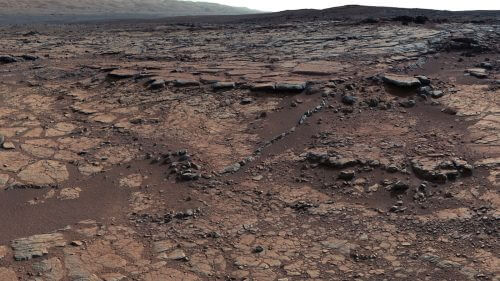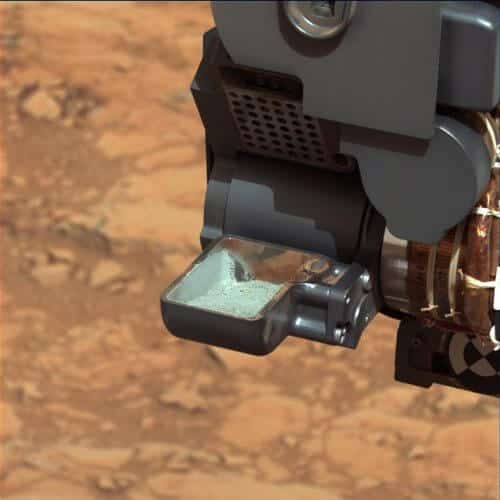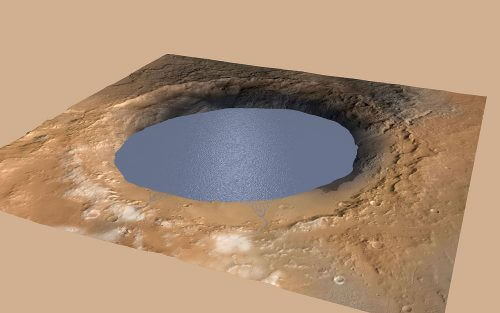How can we bridge the gap between the abundant evidence of the existence of liquid water on the surface of Mars billions of years ago, and the fact that no evidence has been found for a large amount of carbon dioxide in its ancient atmosphere, which is required to heat Mars beyond the freezing point? The mystery, which has troubled Mars researchers for years, is only getting stronger now, after the Curiosity rover also failed to find a certain type of mineral on the surface of the ground, which was supposed to indicate carbon dioxide in the ancient atmosphere of Mars.

Much evidence, collected over decades from both satellite imagery and robotic exploration of the Martian surface, shows that liquid water existed on the Martian surface billions of years ago. In recent years, the robotic research of rovers on the surface has revealed more and more evidence that in the ancient past of Mars there was liquid water both below and above the ground in a stable and long-term manner.
To allow liquid water to exist stably on the surface, Mars would have to be warm enough. But in that early period the Sun's luminosity was about 30% dimmer, which means that the Martian atmosphere would have had to create a greenhouse effect strong enough to heat Mars beyond the freezing point of water.
Mars researchers understood this problem already decades ago, and according to the main solution proposed, the early atmosphere of Mars was a dense atmosphere of carbon dioxide, used as a greenhouse gas, which could have warmed Mars enough to allow liquid water to exist on its surface. To prove this hypothesis, the researchers expected that such an atmospheric composition would leave traces in the form of carbonate minerals that would form on the ground, but to date no significant and sufficient amount of such minerals has been found on Mars.
Now, the mystery only gets stronger, after the rover Curiosity, which investigates the Gale Crater On Mars since its landing in 2012, the rover's excavations failed to find any carbonate minerals. At the same time, the rover found in Gale Crater many evidences of rock sediments formed in an aqueous environment, most likely as the bottom of a lake that existed in the crater about 3.5 billion years ago. The research is new Published this week in the journal Proceedings of the National Academy of Science.

The rover searched for carbonate minerals using the CheMin device (full name: Chemistry & Mineralogy X-Ray Diffraction), included in the rover's mobile laboratory, and identifies the mineral composition in the samples the rover excavated using X-ray transmission through them.
The CheMin device is only able to detect carbonate minerals if they make up more than a low percentage of the rock composition. Even if the carbonates are present in minute amounts in the rock samples examined by the rover, it is a much smaller amount than the researchers expect to find if the early atmosphere of Mars contained a large amount of carbon dioxide.
"We were particularly struck by the lack of carbonate minerals in the rock sediments the rover examined," said Thomas Bristow, a researcher at NASA's Ames Research Center and lead author of the academic paper. "It will be very difficult to reach liquid water even if the amount of carbon dioxide is a hundred times greater than what the mineral evidence in the rocks shows us."
carbonate minerals Formed in an aqueous environment, as a result of the combination of carbon dioxide with positive ions of elements such as magnesium or iron. Because Curiosity found other types of minerals in the rocks it examined, such as Magnetite וClay minerals, the researchers can conclude that such ions were available at that time for the formation of carbonate minerals.

It is possible that the absence of such minerals today is due to the fact that the aqueous environment at some point became acidic enough to dissolve the carbonate minerals. But those other minerals found by Curiosity rule out this possibility.
Based on the new data from Curiosity, the researchers calculated that the maximum amount of carbon dioxide, in the early atmosphere of Mars, is only a few tens of millibars. One millibar is one thousandth of the atmospheric pressure at the surface of the Earth (roughly equal to one bar). For comparison, In a 1987 article Researchers have proposed an atmosphere of 1-5 bar of carbon dioxide to create conditions that allow liquid water to exist.
Even the satellites that NASA sent to orbit Mars, which were equipped with spectrometers that can study the composition of the ground surface from space, failed to find a significant amount of carbonate minerals. The hope of the researchers was that Curiosity would be able to uncover such minerals through direct research on the surface and below the ground.
"It was a mystery why not enough carbonates were seen from orbit around Mars," Bristow said. "You can solve the dilemma and say that carbonates can still be there, but we can't see them from space because they're covered in dust, or buried, or we're not digging in the right place. Curiosity's results bring this paradox into focus. This is the first time we have looked for carbonates on the surface of the ground in rock that we know was formed from underwater sediments."
"This analysis fits with many theoretical studies showing that the surface of Mars, even at this early time, was not warm enough for water to be liquid," said Robert Haberle, a Martian climate researcher at NASA's Ames Research Center and co-author of the article. "It's really a puzzle for me."

At the same time, the meaning of the new study is that Mars researchers have to find an alternative explanation for how in the ancient past of Mars liquid water was stable, and he does not dispute this. Thomas Bristow, the lead author of the paper, clarified this In an interview with Space.com: "It is indisputable that the sedimentary evidence in Gale Crater shows the long-term presence of liquid water on the ground of ancient Mars."
"Curiosity's passage through avenues, doors And mud that sank to the bottom of ancient lakes requires a robust hydrologic system to provide water and sediment to form the rocks we find," said researcher Ashwin Vasavada of NASA's Jet Propulsion Laboratory (JPL). "Carbon dioxide, in combination with other gases such as hydrogen, was one of the leading candidates for the heating effect required for such a system. It seems that this surprising result took him out of the race."
One way to solve the mystery suggests that the lake in Gale Crater was not an open body of water, but was covered by a layer of ice. "It will still be possible to get some sediment that will accumulate at the bottom of the lake if the ice was not very thick," said Robert Harbela. This solution has a drawback in that Curiosity did not find in Gale Crater signs that a frozen lake would be expected to leave behind, such as large, deep cracks known as ice wedges.
Another solution might be other greenhouse gases, such as sulfur dioxide or methane, but according to researcher Thomas Bristow, that's not a good solution to the mystery either. "The problem with all these other greenhouse gases is that they tend to be very reactive, so when you put them in the atmosphere they don't stay there very long," he said in an interview with Space.com.
Bristow and other NASA researchers hope that as the Curiosity mission continues, making its way up the mountain in the center of Gale Crater, Aeolis Mons (and referred to by NASA as "Mount Sharp"), you will find a solution to this central mystery.

6 תגובות
(Continue to the last comment)
In general, it can be said that the pollution of the atmosphere with ash blocks the light frequencies and causes the temperature of the atmosphere and the surface to drop.
On the other hand, greenhouse gases, which are transparent to light frequencies, cause warming due to the greenhouse effect.
to gather a bar.
The statement you bring is interesting, logical and even seems elementary. Therefore, it is strange that it is not indicated that it was tested by Curiosity.
It is possible that the calculations actually predict that the volcanic ash that was dispersed into the red atmosphere, not only did not cause an increase, but on the contrary, caused a great decrease in the temperature of the atmosphere and the surface, as is believed to have occurred according to KDA in the mass extinction events caused by large meteor impacts or volcanic eruptions .
The alternative atmosphere is from the formation of Olympus Manos - the mighty volcanic mountain of Mars. During its eruptions, it scatters a lot of material into the reddish atmosphere, which created a greenhouse effect. When it sank, it gave Mars its reddish color (the atmosphere of Mars sank to the ground)
There must have been another reason for the high temperature on Mars in its wet age.
If we rule out the greenhouse effect then it is possible that the reason lies in the distance of Mars from the Sun
So, it was smaller than its distance from the sun today.
It is possible that the cause of Mars moving away from the Sun is the increase in the strength of the solar wind with
The increase in the brightness of the sun by about 40%. This is a factor that is difficult to verify by measurement, but can be verified
(or negate) in the calculation.